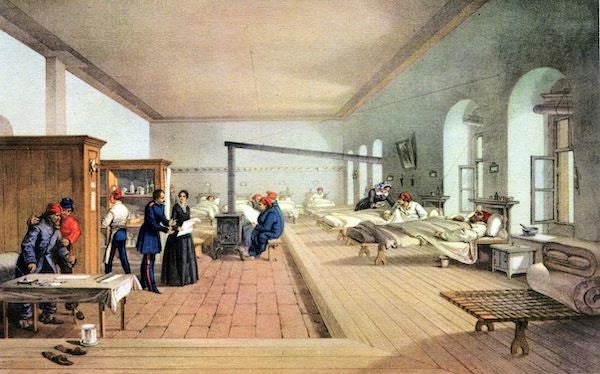
In the late 19th century, Florence Nightingale revolutionized hospital design in what became known as Nightingale wards. The signature innovation of these wards was large windows that allowed cross-ventilation and abundant natural light. Nightingale believed that the light and air quality in a hospital's environment play an important role in speeding patient recovery.
In the decades since, numerous studies have shown that Nightingale was right: daylight is a critical determinant of human health and wellness. Patients in rooms with daylight and views of the outdoors have quicker recovery times and need fewer painkillers. Natural light has been shown to decrease heart rate, lower blood pressure, and even treat depression faster than antidepressants. Importantly, just as Nightingale theorized, daylight can also decrease harmful bacteria and viruses.
Our understanding of how these benefits of light are delivered has advanced dramatically in the past two decades. Up until the end of the last century, it was assumed that all responses to ocular light exposure were mediated by the rods and cones we use to see, located at the back of the retinae. About 20 years ago, however, that assumption was completely transformed when research from many laboratories culminated in the discovery of light-sensitive cells in the ganglion layer at the front of the retinae that can function separately from the visual system.
These cells, dubbed “nonvisual photoreceptors,” play an important role in maintaining our sleep, productivity and overall health. The cells are particularly sensitive to the short-wavelength blue light corresponding closely to peak wavelengths found in sunlight. Exposure to this short-wavelength light stimulates us, keeping us alert, improving reaction times, learning and a range of other cognitive functions. Light, particularly short-wavelength light, also elevates mood, and, in clinical patients, can be used treat depressive disorders and fatigue. Many artificial light sources emit a greater proportion of longer-wavelength light, however, which can undermine the benefits of daylight when indoors.

These nonvisual cells are also the primary timekeeper for our biological clocks—our circadian rhythms—located in the suprachiasmatic nuclei, a region of the hypothalamus in the brain. The circadian system regulates many of our bodily functions, including hormone levels, body temperature and metabolism, among many others. We take this synchronizing effect of light for granted. People who are totally blind—whose eyes cannot detect light—develop a debilitating condition called non-24-hour sleep-wake rhythm disorder, where their biological clocks run in and out of sync with the 24-hour day in a never-ending cycle. We experience a similar but temporary disconnection from the light-dark cycle when we work night shifts or travel quickly across time zones (jet lag).
In no part of our lives does this disconnect manifest itself more clearly than our sleep, as the circadian system strongly influences the timing and quality of sleep. A recent NIH-funded study found that nearly a third of Americans sleep six hours or less each night. According to the Centers for Disease Control and Prevention, sleep disorders are so common in the United States, they now constitute a public health epidemic. Lack of sleep is associated with many chronic health conditions, including heart disease, diabetes, depression and even some forms of cancer. Productivity losses due to poor sleep cost the economy billions of dollars every year. Exposure to a more robust light-dark cycle will help maintain better circadian synchronization and sleep, while greater daytime light exposure will also improve alertness and performance through its direct stimulant properties. In one recent study, office workers provided with increased daylight exposure slept 37 minutes longer compared to when they worked in a similar office with blinds, and exhibited 42 percent higher scores on a cognitive test taken at the end of the workday.
There are a number or ways to improve our access to daylight and improve our health in the process. In an office setting, architectural design can introduce more daylight deeper into buildings through larger windows and low desk partitions. Innovations such as smart glass make it possible to control the amount of daylight that enters through a window by automatically tinting based on cloud cover and the angle of the sun, eliminating the need for blinds and shades, allowing for views of the outdoors. Unlike opt-in employee wellness programs that require people to change their behavior, like gyms, natural light in the office provides wellness in a passive manner, benefiting all occupations equally. In places that are unable to provide ample natural light, workplaces should install daylight-mimicking LED lights with a spectrum peaking in the short-wavelength blue range.
During the COVID-19 pandemic, the same strategies should be applied to our home offices. We can promote our personal sleep quality and daytime productivity by working near a window or outside. In the evening, we can reduce our exposure to light by using dimmer lights, choosing blue-depleted warmer-looking lights, and minimizing use of light-emitting electronic devices for as long as possible before bed.
The benefits of regular exposure to daylight are clear and relatively easy to achieve. Yet, such innovations are implemented too rarely. While building developers and owners may not receive the direct benefit of better lighting, their tenants will, and providing a better environment may differentiate them from their competitors. Tenants, while often unable to design their own spaces, can include daylight access as a deciding factor in selecting real estate so that they reap the benefits of the greater productivity brought about by better lighting design. Bright days and dark nights support the body’s circadian functions, enhance alertness and improve productivity. Simply put, greater access to daylight is the first simple step to better health. Nightingale grasped this more than a century ago. It’s time to put her advice to work.
This is an opinion and analysis article.
"What" - Google News
March 18, 2021 at 08:00PM
https://ift.tt/318cz2t
What Florence Nightingale Can Teach Us about Architecture and Health - Scientific American
"What" - Google News
https://ift.tt/3aVokM1
https://ift.tt/2Wij67R
Bagikan Berita Ini















0 Response to "What Florence Nightingale Can Teach Us about Architecture and Health - Scientific American"
Post a Comment